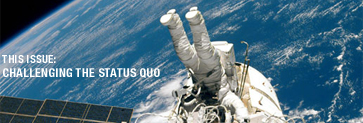By Todd Post
The ASK Magazine prototype appeared in January 2001, and was released to a small group of readers, less than a hundred of some of the most reflective project managers we knew at the time.
The format we chose — stories — was boldly different than any other project management publication we were aware of. This was truly an innovation, and so a prototype seemed like a good way of testing this new concept to see if it was legitimate. We wanted our readers to tell us if we were on the right track, and by producing a prototype we could gain that knowledge quickly in case we needed to rethink our approach.
All I had to start was a stack of transcribed presentations from the APPL Masters Forum of Project Managers from September 2000. It was my job to pull out the best stories and contact the authors to fill in some areas that the editorial team (Ed Hoffman and Alex Laufer and myself) thought deserved more attention.
I learned a tremendous amount about project management at NASA while working on this prototype issue. Let me tell you a little story within this story. When I conducted my first interview with a NASA project manager, Elizabeth Citrin of Goddard Space Flight Center, I began the interview by asking her some generic questions about scheduling and budgets. As an interviewer, you know when you’ve got good material by the excitement you get back from the interviewee. It felt like a stiff interview, until I tossed aside my prepared questions and simply asked her, “So what is it that gets you excited about a project?”
And there the interviewed tipped. Liz told me that it was the science, so I asked her to tell me more about the science on the mission she was project manager on then. Her eyes lit up even brighter, and suddenly we were having a wonderful time talking about the project and its science objectives and how those intersected with her management.
Whenever I do an interview with a NASA project manager, I’m always looking for that tipping point. NASA project managers will speak passionately with me about the work they do and why they love it, but the onus is primarily on me to get them to that tipping point.
Back now to the ASK prototype. We came out with the prototype in January ’01 as intended, and the advice we got from our audience was critical in helping us think through what we wanted to accomplish with ASK. We continue to learn from our readers and adapt the magazine with their help. In that way, the ASK project still feels a bit like a prototype.
In this issue of ASK, you’ll find examples of how prototyping has been used to benefit a range of projects. We reach a much larger audience now than we did when we released the ASK prototype, but we still look forward to hearing from our readers as to how to do a better job. As always, we invite you to share your thoughts with us.







